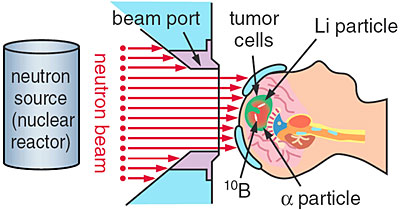Boron Neutron Capture Therapy (BNCT) is a radiation therapy on which clinical studies are being performed throughout the world as a treatment method for one form of obstinacy cancer, malignant brain tumors. Fig. 11-1 shows the principle of BNCT. Currently in Japan, BNCT clinical trials have been performed by using only thermal neutron beams. Recent expectations are that epithermal neutron beams will be applied to BNCT because using an epithermal neutron beam can destroy a malignant tumor deep in the brain.
In the conventional thermal neutron beam BNCT, the dosimetry of the absorbed dose given to the tumor in the target region and to normal tissues around the target region was evaluated by measuring the radiation activity of irradiated Au wires that had been placed directly on the brain's surface at the irradiation field. But this method has several problems, the dosimetry at points deep within the brain cannot be measured by Au wires, and the measurement points are limited. With epithermal neutron beam BNCT that can deliver thermal neutrons to deeper fields in the brain, it is difficult to estimate the absorbed dose of the target region and of some deep organs. Therefore we are developing the JAERI Computational Dosimetry System (JCDS) that can, using numerical simulation, estimate the absorbed doses given to the target region based on irradiation conditions, such as the neutron beam spectrum and direction. Further, the irradiation time of a BNCT can be decided base on information from the JCDS calculation. Fig. 11-2 shows the dosimetry process of a BNCT with JCDS.
The JCDS creates a three-dimensional detailed model of a patient's head by using CT and MRI medical imaging data of the patient, and calculates the absorbed doses inside and outside the target region using the MCNP code, a general Monte Carlo neutron-particle transport code.
The development of JCDS enables the estimation of the absorbed doses around the target region deep in the brain where the field is impossible to estimate by the conventional method. Doctors can prescribe a treatment plan, including the optimum irradiation condition for each patient, based on the detailed dosimetry results obtained from the JCDS including several calculation conditions determined in advance. Therefore, it is now possible to perform clinical trials of the epithermal neutron beam BNCT. We are advancing the research and development of JCDS continuously to perform the dose calculation more accurately and in less time. The development of JCDS improves the results of the treatment, and therefore is expected to contribute to the success of the BNCT clinical trials.
|

